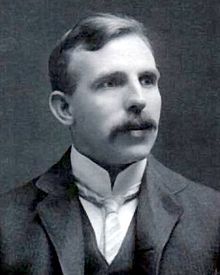
Ernest Rutherford, 1st Baron Rutherford of Nelson OM, FRS (30 August 1871 - 19 October 1937) was a New Zealand-born British chemist and physicist who became known as the father of nuclear physics. He is considered the greatest experimentalist since Michael Faraday (1791-1867).
In early work he discovered the concept of radioactive half-life, proved that radioactivity involved the transmutation of one chemical element to another, and also differentiated and named alpha and beta radiation, proving that the former was essentially helium ions. Wikipedia, Rutherford
Ernest Rutherford was born on 30th August 1871, at Brightwater, South Island, New Zealand. He was the fourth of 12 children. His mum was a school teacher and his dad a farmer.
Ernest would go on the become a great scientist and a pioneer in physics. The city of Manchester is proud of its connection with this world-famous New Zealander, for the time that he spent here and the work he carried out at the university.
By the time he came to Manchester in 1907, Rutherford was 36 and had already carried out ground-breaking work in physics whilst working at Cambridge (where he worked under JJ Thomson) and in Canada. In 1908, he was awarded a Nobel Prize in Chemistry for that.
Rutherford spent only 12 years at Manchester University (1907-19), but during that time he came up with a new model for the atom and its nucleus.
He said the nucleus of an atom was very, very small; about ten thousand times smaller than the atom itself. He compared it to the size of “a fly in a Cathedral”. Through a series of experiments which he conducted at his laboratory just off Oxford Road, he proved the existence of the nucleus, with electrons whizzing around it. Despite the nucleus being so small, most of the mass of the atom was concentrated there, with the rest being in the orbiting electrons. The nucleus was also positively charged.
Having come up with this model of an atom, Rutherford set about experiments to prove that the tiny nucleus was made up of even smaller parts, neutrons and protons. By firing particles at the nucleus, he carried out the first artificially induced nuclear reaction. It was this work, which came to be popularly known as “splitting the atom” for which Rutherford is most famous.
It was pioneering work that changed the face of science.
Thus, it was in Manchester that he virtually created a new field of science: nuclear physics, and he was knighted for his work here.
It is important to add that, in all his work at Manchester, Rutherford was aided by one of the finest teams of scientists ever assembled. His “nuclear family” included Hans Geiger (who went on to invent the radiation counter), Lawrence Bragg (who won the 1915 Nobel Prize for his work on X-ray crystallography), Ludwig Wittgenstein (analytic philosopher) and the great Niels Bohr (seen by many as one of the most gifted scientists of the 20th century).
Ernest Rutherford died in 1937, aged 66, and is buried in Westminster Abbey (close to Sir Isaac Newton). Small wonder then, that Manchester is proud of its connection with Ernest Rutherford, a man that Albert Einstein would later call "a second Newton".
On October 19 we remember a New Zealand scientist whose work changed the structure of physics forever. His early studies in radioactivity earned him the 1908 Nobel Prize in Chemistry. This recognition came before his most famous discovery showing how extraordinary his scientific path already was.
After receiving the prize he continued exploring how particles move and interact inside atoms. Through precise experiments he found that most atomic mass sits in a tiny central region. This insight showed that the atom is mostly empty space with a dense core at the center.
His discovery of the nucleus changed every field that relied on atomic structure. Chemists gained a new way to explain reactions and stability while physicists saw a path toward deeper theories. His work encouraged future scientists to question long held models.
He relied on patient observation simple tools and clear logic. Encyclopaedia Britannica called him the greatest experimentalist since Michael Faraday. This praise reflects not only his discoveries but also the care and clarity he brought to each experiment.
Today his name Ernest Rutherford stands as a landmark figure in science. His work guides modern nuclear physics explains how atoms behave and shapes technologies that rely on atomic understanding. His discoveries remain central to how we view the building blocks of matter.
See Also
